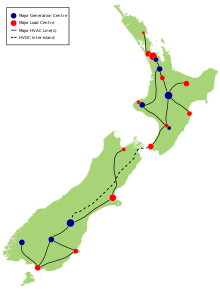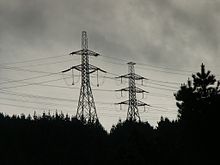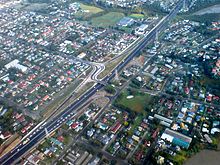- National Grid (New Zealand)
-
 The major transmission network in New Zealand. Generation and load centres are shown as blue and red circles respectively. The major AC transmission corridors are shown as black lines, with the HVDC Inter-Island shown as a dashed line.
The major transmission network in New Zealand. Generation and load centres are shown as blue and red circles respectively. The major AC transmission corridors are shown as black lines, with the HVDC Inter-Island shown as a dashed line.
The National Grid is the nationwide system of electric power transmission in New Zealand. The grid is owned and operated by Transpower New Zealand Limited, a State owned enterprise.
Contents
Transmission
 A 220kV transmission line (back) and the HVDC Inter-Island transmission line (front) near the Cook Strait in Wellington.
A 220kV transmission line (back) and the HVDC Inter-Island transmission line (front) near the Cook Strait in Wellington.
Existing
See also: HVDC Inter-IslandNew Zealand's national electricity transmission grid is owned, operated, and maintained by state-owned enterprise Transpower New Zealand Limited. In total, the national grid contains 11,803 kilometres (7,334 mi) of high-voltage lines and 178 substations.[1]
The backbone of New Zealand's national grid is the network of 220 kV transmission lines in each of the North and South Islands, which links the major power stations and the country's major cities. Supplementing this are 110 kV, 66 kV and 50 kV transmission lines, which supply provincial towns and cities with electricity from the 220 kV grid, and also connect smaller power stations to the grid.
The HVDC Inter-Island is New Zealand's only high voltage direct current (HVDC) system, and links the North and South Island grids together. The line connects to the South Island 220 kV grid at Benmore Dam in Southern Canterbury, and travels via pylons for 535 kilometres (332 mi) to Fighting Bay in Marlborough. From here, it crosses the Cook Strait via undersea cables for 40 km to Oteranga Bay, west of Wellington. At Oteranga Bay, the HVDC line converts back to pylons to cover the last 35 km, with the line terminating and connecting to the North Island's 220 kV grid at Haywards in Lower Hutt. The main reason for a HVDC connection between the two islands is due to New Zealand's geography and demographics. The South Island has a large number of rivers suitable for hydroelectricity generation, however 75% of New Zealand's population lives in the North Island. HVDC was chosen to allow reactive power from the South Island's plentiful power supply to travel north to the North Island to meet the North Island's electricity requirements.
Often in the media is the state of Auckland's power grid, which had several famous blackouts, such as the 5-week long 1998 Auckland power crisis or the much shorter 2006 Auckland Blackout. Both were caused when crucial elements of the grid failed. Due to the rising power demand and the geographical nature of the grid (almost all of Auckland's power comes from the south, and of these, all but one 110 kV line converges on Otahuhu substation[2]), there was (and still is) only very limited redundancy in the local grid.
On 30 October 2009 at around 8:00am, power was cut to the whole of Northland and most of the northern half of Auckland, affecting 280,000 consumers (14.5% of the country). A forklift carrying a shipping container accidentally hit one of the Otahuhu to Henderson 220 kV circuits while the other circuit was out for maintenance, leaving the region supplied by four low capacity 110 kV circuits. Power was restored to the entire region around 11:00am.[3]
Proposed
One of the largest and most contentious projects (as of 2009) is the North Island Grid Upgrade (NIGU) between the southern Waikato and Central Auckland. The plan involves a 220kV switching station at Drury, upgrading the existing 220kV Otahuhu to Whakamaru C line, new capacitors at Otahuhu, Penrose, and Hepburn Road substations, and the construction of a new 220/400kV transmission line between Whakamaru and Pakuranga.[4] The proposal is being fought by numerous local farmers and lifestyle block owners who consider that the new pylon lines and upgrades to existing lines would cause significant amenity loss. They also allege that the process that led to the decision to construct the network upgrade was legally flawed. An appeal currently being prepared to go to the High Court of New Zealand is expected to cost up to NZ 1 million.[5] Anger about the proposal, claimed to intend the construction of pylons three times as high as previous New Zealand projects, has already led to threats of sabotage against a future line.[6]
Other major projects currently proposed include:
- A NZ$600 million HVDC Inter-Island upgrade, which involves replacing the aging mercury arc rectifier Pole 1 with a new thyristor valve pole, and upgrades at the endpoints of Benmore and Haywards to allow the link to carry up to 1000MW with future provisions for 1400MW[7][8]
- A NZ$521 million upgrade between central Auckland and North Shore. This involves building a new 220 kV cross-harbour underground link between Pakuranga, Penrose, Hobson Street (Auckland CBD), Wairau Road (North Shore City), and Albany, crossing the Waitemata Harbour underneath the Auckland Harbour Bridge. This is to increase supply security to central Auckland, the North Shore, and further afield to Northland. [9]
See also
- List of power stations in New Zealand
- Electricity sector in New Zealand
- New Zealand electricity market
References
- ^ "A Guide to Transpower 2009". http://www.transpower.co.nz/f2484,12225290/12225290_guide-to-transpower.pdf. Retrieved 2009-04-16.
- ^ "North Island Grid Map". July 2006. http://www.gridnewzealand.co.nz/f70,3572/3572_transmission-map-ni.pdf. Retrieved 2009-03-17.
- ^ "Forklift sparks blackout for thousands - tvnz.co.nz". Television New Zealand. 30 October 2009. http://tvnz.co.nz/national-news/forklift-sparks-blackout-thousands-3102479. Retrieved 29 September 2011.
- ^ "North Island Grid Upgrade Overview Grid New Zealand - Transpower". http://www.gridnewzealand.co.nz/n149.html. Retrieved 2009-05-14.
- ^ O'Rourke, Simon (23 November 2007). "Farmers and lifestylers digging deep to continue battle against pylons". The New Zealand Herald. http://www.nzherald.co.nz/topic/story.cfm?c_id=187&objectid=10477871. Retrieved 27 October 2011.
- ^ Fisher, David (13 January 2008). "Pylons apart in NZ's power war". The New Zealand Herald. http://www.nzherald.co.nz/section/1/story.cfm?c_id=1&objectid=10486520. Retrieved 27 October 2011.
- ^ "HDVC Pole 1 replacement - Grid New Zealand - Transpower". http://www.gridnewzealand.co.nz/n278.html. Retrieved 2009-05-14.
- ^ "Big tick for wind as power of the future". The New Zealand Herald. 2007-11-26. http://www.nzherald.co.nz/topic/story.cfm?c_id=187&objectid=10478280.
- ^ "Transpower submits $521m grid upgrade plans". The New Zealand Herald. 25 September 2007. http://www.nzherald.co.nz/topic/story.cfm?c_id=187&objectid=10465791.
External links
- Grid New Zealand - information about Transpower's existing and future investment in the National Grid
- Transpower New Zealand
Categories:- Energy in New Zealand
- Electric power transmission systems in New Zealand
Wikimedia Foundation. 2010.

